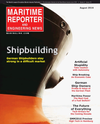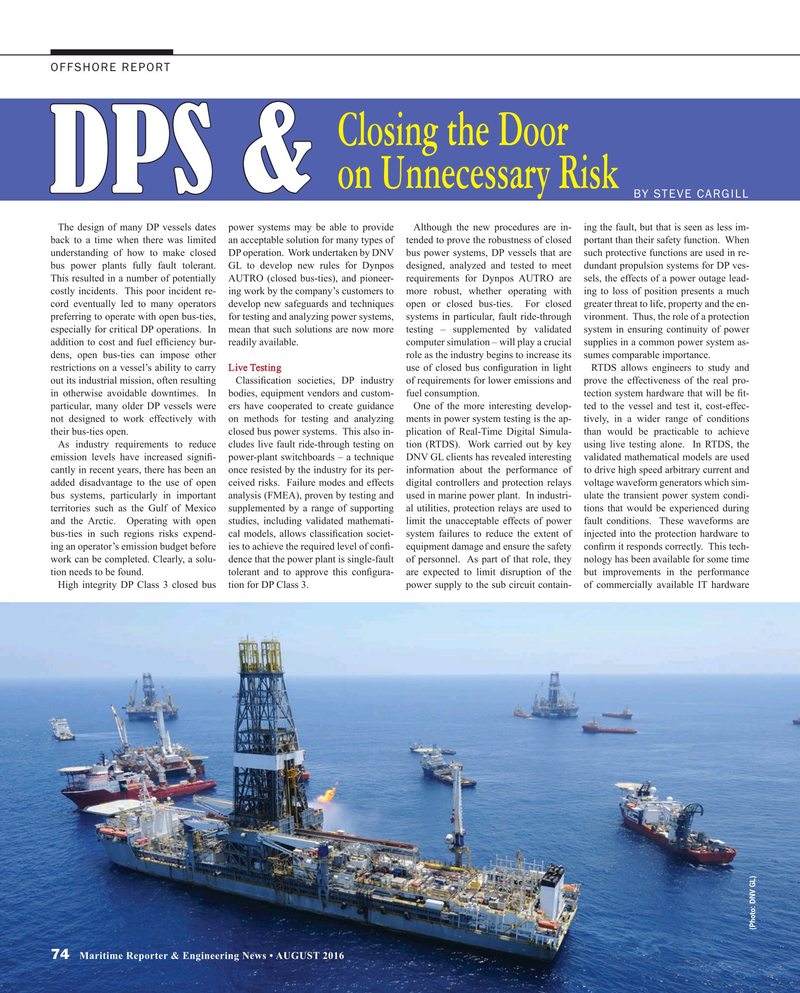
Page 74: of Maritime Reporter Magazine (August 2016)
The Shipyard Edition
Read this page in Pdf, Flash or Html5 edition of August 2016 Maritime Reporter Magazine
OFFSHORE REPORT
Closing the Door on Unnecessary Risk
DPS &
BY STEVE CARGILL
The design of many DP vessels dates power systems may be able to provide Although the new procedures are in- ing the fault, but that is seen as less im- back to a time when there was limited an acceptable solution for many types of tended to prove the robustness of closed portant than their safety function. When understanding of how to make closed DP operation. Work undertaken by DNV bus power systems, DP vessels that are such protective functions are used in re- bus power plants fully fault tolerant. GL to develop new rules for Dynpos designed, analyzed and tested to meet dundant propulsion systems for DP ves-
This resulted in a number of potentially AUTRO (closed bus-ties), and pioneer- requirements for Dynpos AUTRO are sels, the effects of a power outage lead- costly incidents. This poor incident re- ing work by the company’s customers to more robust, whether operating with ing to loss of position presents a much cord eventually led to many operators develop new safeguards and techniques open or closed bus-ties. For closed greater threat to life, property and the en- preferring to operate with open bus-ties, for testing and analyzing power systems, systems in particular, fault ride-through vironment. Thus, the role of a protection especially for critical DP operations. In mean that such solutions are now more testing – supplemented by validated system in ensuring continuity of power addition to cost and fuel ef? ciency bur- readily available. computer simulation – will play a crucial supplies in a common power system as- dens, open bus-ties can impose other role as the industry begins to increase its sumes comparable importance. restrictions on a vessel’s ability to carry Live Testing use of closed bus con? guration in light RTDS allows engineers to study and out its industrial mission, often resulting Classi? cation societies, DP industry of requirements for lower emissions and prove the effectiveness of the real pro- in otherwise avoidable downtimes. In bodies, equipment vendors and custom- fuel consumption. tection system hardware that will be ? t- particular, many older DP vessels were ers have cooperated to create guidance One of the more interesting develop- ted to the vessel and test it, cost-effec- not designed to work effectively with on methods for testing and analyzing ments in power system testing is the ap- tively, in a wider range of conditions their bus-ties open. closed bus power systems. This also in- plication of Real-Time Digital Simula- than would be practicable to achieve
As industry requirements to reduce cludes live fault ride-through testing on tion (RTDS). Work carried out by key using live testing alone. In RTDS, the emission levels have increased signi? - power-plant switchboards – a technique DNV GL clients has revealed interesting validated mathematical models are used cantly in recent years, there has been an once resisted by the industry for its per- information about the performance of to drive high speed arbitrary current and added disadvantage to the use of open ceived risks. Failure modes and effects digital controllers and protection relays voltage waveform generators which sim- bus systems, particularly in important analysis (FMEA), proven by testing and used in marine power plant. In industri- ulate the transient power system condi- territories such as the Gulf of Mexico supplemented by a range of supporting al utilities, protection relays are used to tions that would be experienced during and the Arctic. Operating with open studies, including validated mathemati- limit the unacceptable effects of power fault conditions. These waveforms are bus-ties in such regions risks expend- cal models, allows classi? cation societ- system failures to reduce the extent of injected into the protection hardware to ing an operator’s emission budget before ies to achieve the required level of con? - equipment damage and ensure the safety con? rm it responds correctly. This tech- work can be completed. Clearly, a solu- dence that the power plant is single-fault of personnel. As part of that role, they nology has been available for some time tion needs to be found. tolerant and to approve this con? gura- are expected to limit disruption of the but improvements in the performance
High integrity DP Class 3 closed bus tion for DP Class 3. power supply to the sub circuit contain- of commercially available IT hardware (Photo: DNV GL) 74 Maritime Reporter & Engineering News • AUGUST 2016
MR #8 (74-81).indd 74 8/2/2016 3:18:16 PM

 73
73

 75
75
